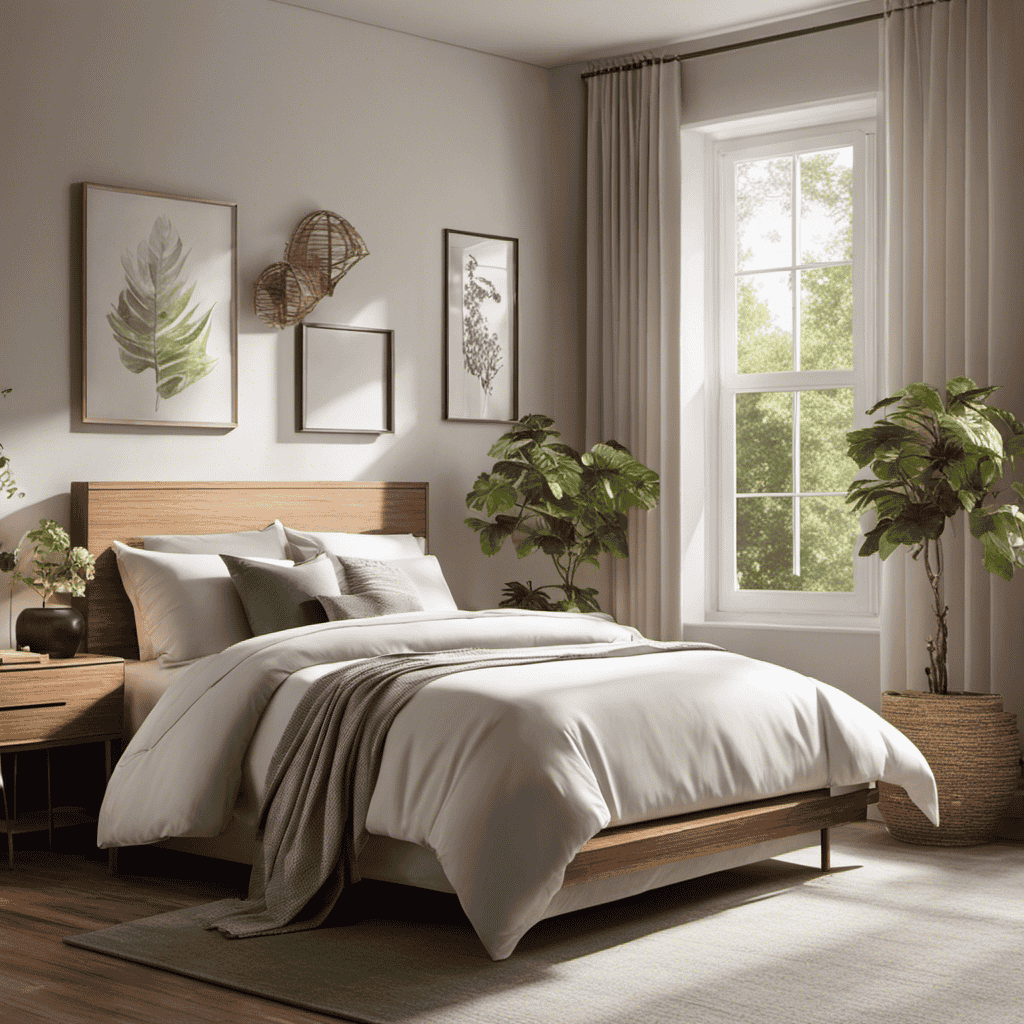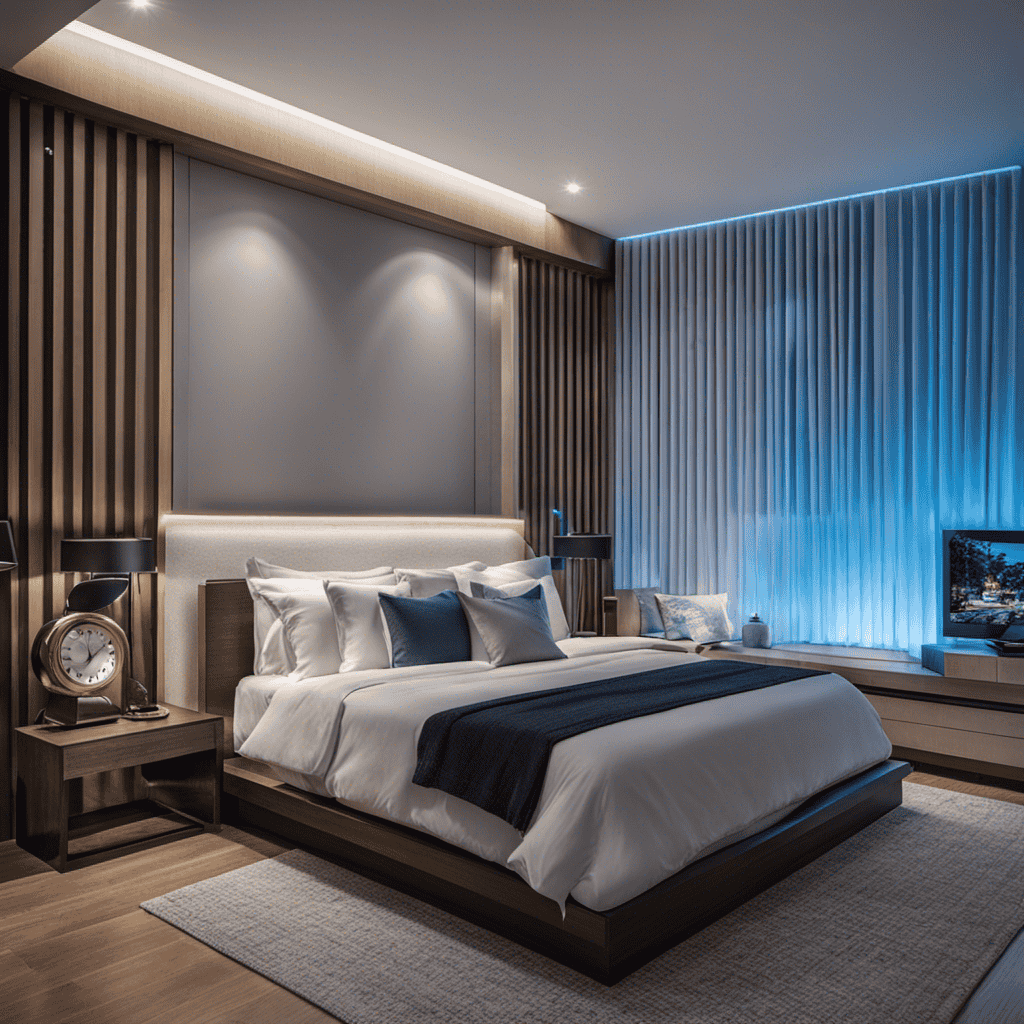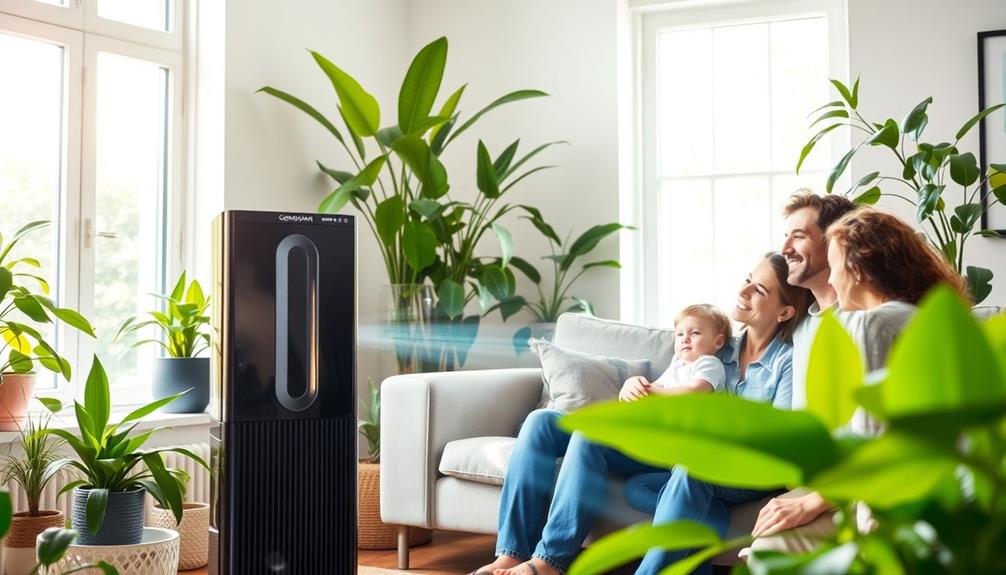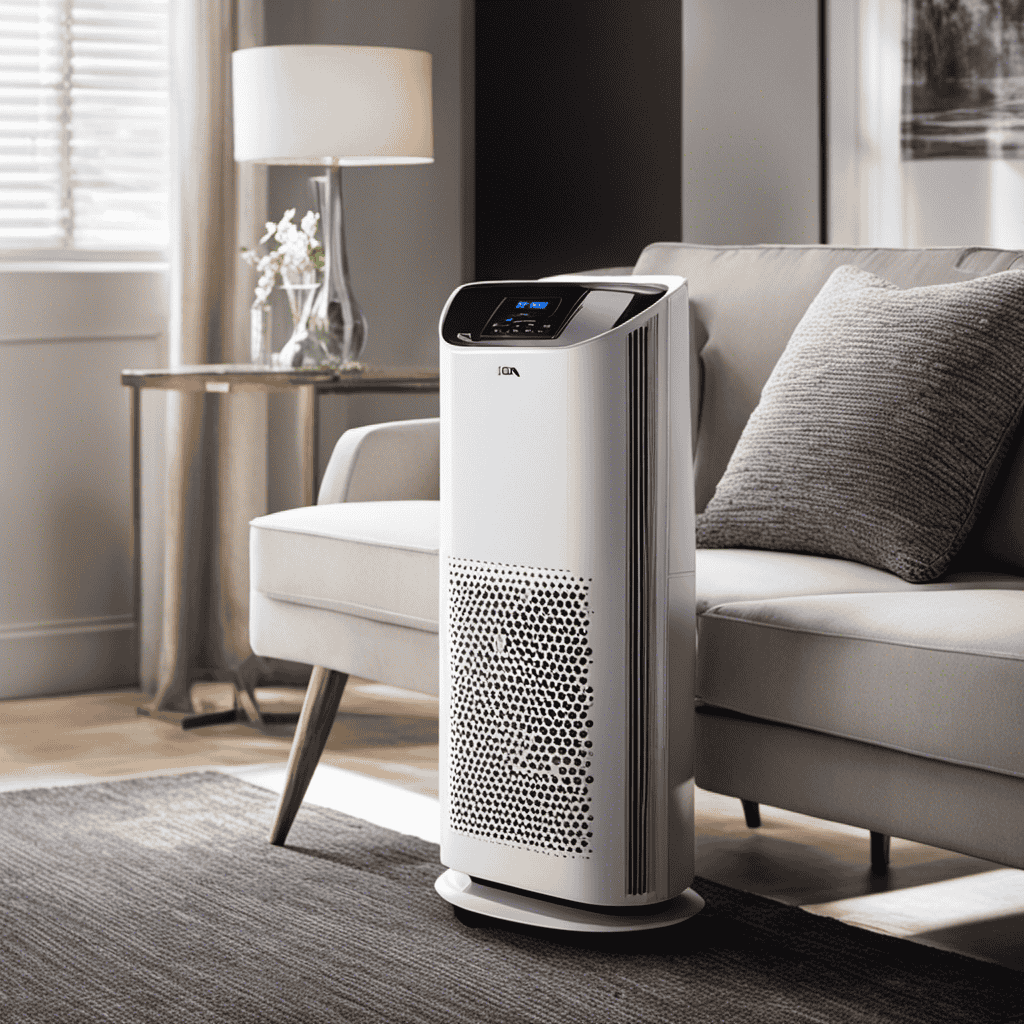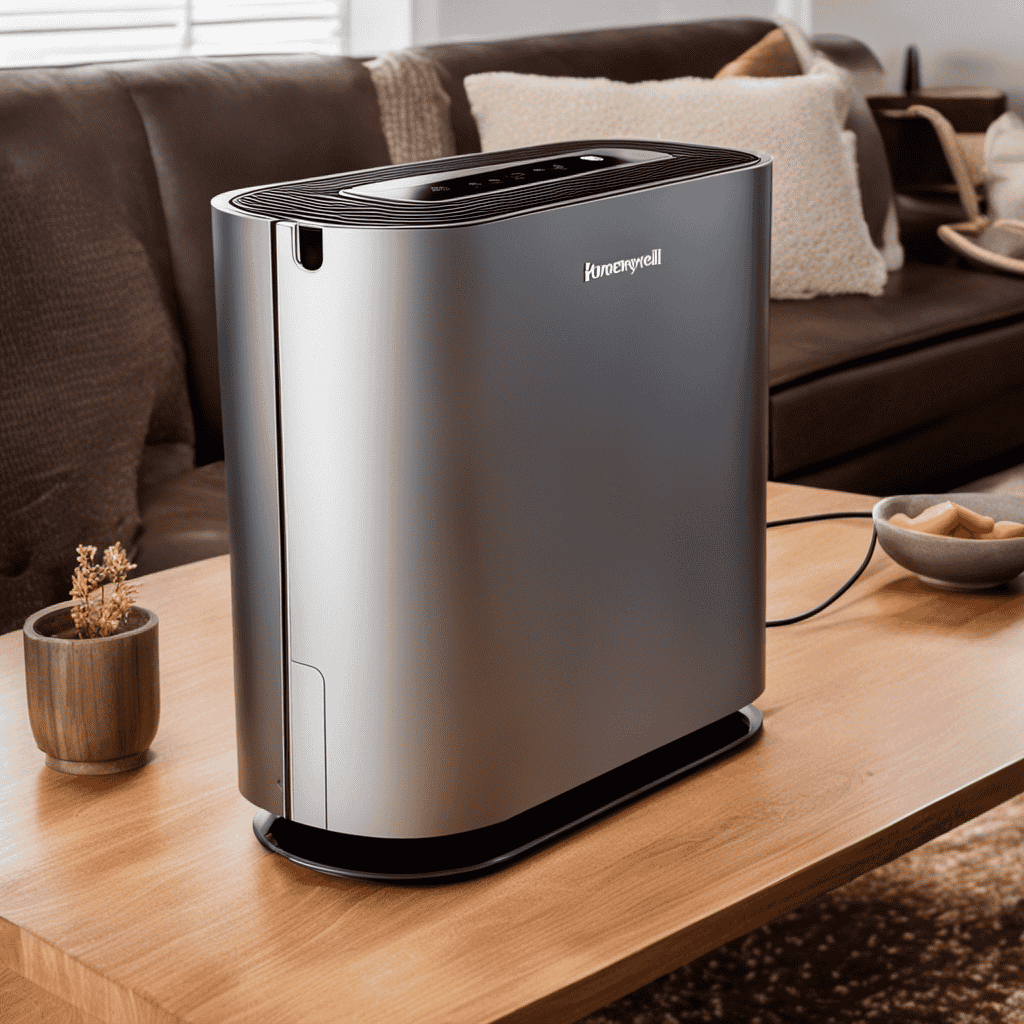I’ve always been curious about the best duration for running my air purifier to guarantee clean and fresh air. Upon conducting research, I found some valuable insights that I’d like to pass on to you.
Factors such as room size, pollutant levels, allergies, and even pet dander can all play a role in determining the recommended duration for running an air purifier.
So, let’s dive in and find out the best practices for maximizing the effectiveness of your air purifier.
Key Takeaways
- The recommended duration for running an air purifier varies based on factors such as room size, pollutant levels, allergies, and pet dander. It is generally advised to run the air purifier for a few hours each day, but longer durations may be needed for larger rooms or high pollution areas.
- Running the air purifier throughout the night can improve sleep quality. It is important to consider sleep mode options and check the manufacturer’s instructions for the recommended duration of usage.
- Different types of air purifiers are available, including those with HEPA filters that capture particles as small as 0.3 microns, activated carbon filters that eliminate odors and harmful gases, and UV-C light purifiers that destroy viruses and bacteria. However, ozone generators, while effective in removing strong odors, have health risks associated with them.
- Monitoring pollutant levels with an air quality monitor is important to understand the effectiveness of pollutant removal capabilities. Regular filter replacement and maintaining a clean indoor environment are crucial for the efficiency of the air purifier.
Factors to Consider
When deciding how long to leave your air purifier on, there are a few factors you should consider.
The optimal running time of an air purifier depends on various factors, such as the size of the room, the air quality, and the specific needs of the occupants.
If you live in a highly polluted area or have respiratory issues, it may be beneficial to keep the air purifier running continuously. However, if you only need it for occasional use or have a smaller space to purify, running it for a few hours a day should be sufficient.
Additionally, it is essential to consider the filter replacement schedule recommended by the manufacturer. Regularly changing the filters ensures that the air purifier continues to function effectively and efficiently.
Recommended Duration
To get the most benefit, you should run your air purifier for at least a few hours each day. However, the recommended duration may vary depending on several factors to consider, such as the size of your room, the level of air pollution, and your sleep duration.
For smaller rooms or areas with low pollution levels, running the air purifier for a few hours during the day should be sufficient. But if you have a larger room or live in an area with high pollution levels, it is advisable to run the air purifier for longer periods, even throughout the night while you sleep.
This ensures that you have clean, purified air all night long, which can greatly improve your sleep quality and overall well-being.
Room Size and Air Purifier Capacity
The size of your room will determine how long you should run your air purifier. To ensure optimal purification duration, it is important to consider the recommended duration based on the capacity of your air purifier.
For smaller rooms, such as a bedroom or office, running the air purifier for at least 6-8 hours a day should be sufficient to maintain clean air quality. However, for larger rooms or open living spaces, it is recommended to run the air purifier for a longer duration, ideally 12-24 hours a day, to ensure thorough purification.
Allergies and Sensitivities
When it comes to allergies and sensitivities, finding the optimal purification duration is crucial for maximum effectiveness.
Allergies and sensitivities can vary in severity and individuals may have different sensitivities to various allergens.
It is important to understand the difference between allergies and sensitivities, as this can impact the effectiveness of an air purifier in addressing specific concerns.
Therefore, when choosing an air purifier, it is essential to consider its effectiveness in eliminating allergens and sensitivities to ensure a clean and healthy environment.
Optimal Purification Duration
You should consider the optimal purification duration for your air purifier. One important factor to consider is the recommended duration for operating your air purifier. This can vary depending on the specific model and the size of the room you are purifying. Most air purifiers have a recommended duration of 8 to 12 hours per day for maximum effectiveness. However, some purifiers also have a sleep mode operation that allows you to run the purifier continuously throughout the night at a lower fan speed. This can be beneficial for those with allergies or sensitivities who want to ensure clean air while they sleep. It’s important to check the manufacturer’s instructions for your specific air purifier to determine the recommended duration and any sleep mode options available.
| Pros | Cons |
|---|---|
| – Removes airborne pollutants | – Increased energy consumption |
| – Improves indoor air quality | – Noise levels may be disruptive |
| – Reduces allergy symptoms | – Replacement filter costs |
| – Creates a healthier living environment | – Requires regular maintenance |
Allergies Vs Sensitivities
Allergies and sensitivities can impact how long you should run your air purifier.
When it comes to allergies, it is important to consider the specific triggers such as pollen and dust mites. These allergens can be present both indoors and outdoors, so it is crucial to understand the source of your allergies.
If you are allergic to outdoor pollutants, like pollen, you may want to run your air purifier for longer periods of time, especially during peak allergy seasons.
On the other hand, sensitivities to indoor pollutants, such as dust mites, may require continuous operation of the air purifier to maintain a clean and allergen-free environment.
It is important to consult with a healthcare professional to determine the optimal duration for running your air purifier based on your specific allergies and sensitivities.
Air Purifier Effectiveness
The effectiveness of an air purifier can vary depending on the specific pollutants present in the environment. To achieve optimal air purifier settings, it is essential to understand the different types of air purifiers available and their effectiveness in combating specific pollutants.
HEPA (High-Efficiency Particulate Air) filters are known for their ability to capture particles as small as 0.3 microns, making them effective in removing dust, pollen, and pet dander.
Activated carbon filters are excellent at eliminating odors and harmful gases.
UV-C light purifiers can destroy viruses and bacteria, while ozone generators can remove strong odors but should be used with caution due to potential health risks.
It is crucial to select an air purifier that suits your specific needs and consider factors such as room size, pollutant type, and the purifier’s clean air delivery rate (CADR) to ensure its effectiveness.
Pollutant Levels
Pollutant levels can be monitored by using an air quality monitor. This device provides real-time data on the concentration of different pollutants present in the air.
When considering air purifiers, it’s important to understand the effectiveness of their pollutant removal capabilities. Here are two key factors to consider:
-
Pollutant removal: Different air purifiers employ various technologies to remove pollutants from the air, such as HEPA filters, activated carbon filters, or electrostatic precipitators. Understanding the specific pollutants a purifier is designed to remove can help ensure it aligns with your needs.
-
Filter replacement: Air purifiers require regular filter replacement to maintain their efficiency. Over time, filters can become clogged with pollutants, reducing their effectiveness. It is crucial to follow the manufacturer’s guidelines and replace filters as recommended to ensure optimal pollutant removal.
Considering pollutant removal capabilities and regular filter replacement are essential to maintain a clean and healthy indoor environment.
Now let’s explore the impact of the time of day on air purifier usage.
Time of Day
When it comes to choosing the optimal purifying hours for your air purifier, understanding the difference between nighttime and daytime usage is essential.
During the nighttime, when we are typically asleep and our homes are closed up, air pollutants can accumulate and affect our indoor air quality.
On the other hand, during the daytime, when our homes are more likely to be open and ventilated, the air purifier can work more efficiently to filter out pollutants and improve the air we breathe.
Therefore, it is important to consider these factors when determining the optimal purifying hours for your air purifier.
Optimal Purifying Hours
You should consider the optimal purifying hours for your air purifier. Finding the recommended timing can greatly improve the effectiveness of your purifier and ensure that you are getting the most out of it.
Here are a few key points to keep in mind:
-
Daytime hours, particularly mid-morning to mid-afternoon, are generally the best time to run your air purifier. This is when air pollution tends to be at its highest due to outdoor activities and traffic.
-
If you suffer from allergies or asthma, running the purifier during the night can also be beneficial. This can help reduce the presence of allergens and improve your sleep quality.
-
It’s important to remember that running the purifier for extended periods of time can put strain on the motor and filters. Regular maintenance, such as cleaning or replacing filters, is crucial to keep your purifier functioning optimally.
Nighttime Vs. Daytime
Running the purifier at night can be beneficial for individuals with allergies or asthma. Not only does it help to remove allergens and pollutants from the air, but it also allows for a more peaceful and uninterrupted sleep.
The nighttime effectiveness of an air purifier is crucial because it is when our bodies are most vulnerable to allergens and irritants. By running the purifier throughout the night, we can wake up feeling refreshed and breathing easier.
On the other hand, running the purifier during the day can contribute to increased daytime productivity. It ensures that the air we breathe is clean and free from contaminants, allowing us to focus and concentrate better on our tasks.
Transitioning into the next section about ‘sleep mode vs. continuous operation,’ let’s explore the different settings and their benefits.
Sleep Mode Vs. Continuous Operation
If you want to conserve energy while using your air purifier, try using sleep mode instead of keeping it continuously running. Sleep mode has several benefits that make it a great option for nighttime use.
First, it typically operates at a lower fan speed, which not only reduces noise but also saves energy. Second, sleep mode often has a timer function that allows you to set a specific duration for operation, ensuring that the purifier runs only when needed.
On the other hand, continuous operation can have some drawbacks. It consumes more energy and can lead to faster wear and tear of the purifier’s components. Therefore, using sleep mode is a more efficient and sustainable option for conserving energy while still enjoying the benefits of clean air.
Speaking of energy consumption, let’s explore how long you should leave your air purifier on.
Energy Consumption
When it comes to optimizing air purifier runtime and minimizing energy usage, there are a few key points to consider.
First and foremost, it’s important to determine the optimal runtime for your specific air purifier model. This can vary based on factors such as room size, air quality, and personal preferences.
Additionally, implementing energy-saving features such as timers and sensors can help reduce energy consumption without compromising on the effectiveness of the air purifier.
Optimal Air Purifier Runtime
To maximize its effectiveness, it’s important to determine the optimal runtime for your air purifier. Finding the recommended duration for running your air purifier will ensure that you are getting the most out of its purification capabilities.
Here are a few factors to consider when determining the optimal purification duration:
-
Room Size:
-
For smaller rooms, running the air purifier for a shorter duration may be sufficient.
-
Larger rooms may require a longer runtime to effectively purify the air.
-
Air Quality:
-
If you live in an area with high levels of pollution or have frequent indoor pollutants, such as pets or smokers, a longer runtime may be necessary.
-
In areas with better air quality, a shorter runtime may be sufficient for maintaining clean air.
Minimizing Energy Usage
One way to reduce energy usage is by adjusting the runtime of your air purifier. By using the recommended settings and taking advantage of the power saving mode, you can effectively minimize energy consumption without compromising the air quality in your home.
It is important to note that the optimal runtime for an air purifier may vary depending on factors such as room size, air quality, and personal preferences. However, a general guideline is to run the air purifier for about 8-12 hours a day in order to maintain clean and fresh air.
Additionally, using the power saving mode, which typically adjusts the fan speed and reduces energy consumption, can further reduce the energy usage of your air purifier without sacrificing its efficiency.
Manufacturer’s Recommendations
You should follow the manufacturer’s recommendations on how long to leave the air purifier on. The recommended duration for optimal purification varies depending on the specific model and brand.
However, there are a few general guidelines to keep in mind:
- Consider the room size: Larger rooms may require longer purification durations to effectively clean the air.
- Check the air quality: If the air in your home is heavily polluted or you have specific allergens present, it may be advisable to run the air purifier for longer periods.
- Monitor the filter: Some air purifiers have indicator lights that let you know when the filter needs to be replaced. If the indicator light is on, it’s essential to follow the manufacturer’s recommendations for filter replacement.
Air Quality Monitoring
When it comes to maintaining optimal air quality levels, monitoring air pollution sources is of utmost importance.
As an expert in the field, I can confidently say that understanding the sources of air pollution allows us to take appropriate measures to mitigate its effects.
Optimal Air Quality Levels
To maintain optimal air quality levels, it’s important to leave the air purifier on for the recommended amount of time. This ensures that the air in your home is constantly being filtered and cleaned, providing you with fresh and healthy air to breathe.
Here are some maintenance tips to help you achieve optimal air circulation:
-
Regularly clean or replace the filters: Over time, the filters in your air purifier can become clogged with dust and other particles. Cleaning or replacing them on a regular basis will ensure that your purifier is operating at its best.
-
Keep the area around the purifier clear: Make sure there are no obstructions around your air purifier, such as furniture or curtains. This will allow for proper air flow and help to maximize the purifier’s effectiveness.
Monitoring Air Pollution Sources
Now that we understand optimal air quality levels, let’s discuss the importance of monitoring air pollution sources.
Air pollution control plays a crucial role in maintaining indoor air quality and ensuring a healthy living environment. By identifying and monitoring the sources of air pollution, we can take necessary steps to reduce their impact on indoor air quality.
This may involve regular maintenance of HVAC systems, using air purifiers or filters, and minimizing the use of pollutants such as cleaning chemicals or smoking indoors. By actively monitoring and controlling air pollution sources, we can significantly improve the air quality in our homes and workplaces, reducing the risk of respiratory issues and other health problems.
Transitioning into the next section, let’s now explore the health benefits of maintaining good indoor air quality.
Health Benefits
You can really benefit from using an air purifier, as it helps improve the air quality in your home. Here are some reasons why air purifiers are beneficial for your long-term health:
-
Reduces Allergens: Air purifiers can remove common allergens like pollen, dust mites, and pet dander from the air, providing relief for allergy sufferers. By reducing allergens, air purifiers can help prevent or alleviate symptoms such as sneezing, coughing, and itchy eyes.
-
Removes Harmful Particles: Air purifiers can also capture and eliminate harmful particles like smoke, bacteria, and viruses. By doing so, they can reduce the risk of respiratory infections and other health issues associated with exposure to these pollutants.
Investing in an air purifier can have long-lasting benefits for your health. By improving the air quality in your home, you can breathe easier and reduce the risk of developing respiratory problems.
Odor Elimination
Eliminating odors is one of the key benefits of using an air purifier. Whether it’s the lingering smell of cooking, pet odors, or musty odors, an air purifier can effectively remove these unpleasant smells and improve the overall air quality in your home. To ensure optimal odor elimination, it’s important to leave the air purifier on for a sufficient duration. The optimal duration can vary depending on the severity of the odors and the size of your room. It’s recommended to leave the air purifier on for at least a few hours or even overnight to allow it enough time to filter the air effectively. To evaluate the effectiveness of the air purifier in eliminating odors, you can use a simple table like the one below:
| Odor Type | Before Air Purifier | After Air Purifier |
|---|---|---|
| Cooking Odors | Strong | Mild |
| Pet Odors | Noticeable | Faint |
| Musty Odors | Lingering | Absent |
| Smoke Odors | Heavy | Reduced |
Pet Dander and Allergens
To effectively reduce pet dander and allergens in your home, it’s important to regularly clean and maintain your air purifier. Here are some steps you can take to ensure your air purifier is functioning optimally:
-
Clean the pre-filter: This is the first line of defense against larger particles like pet hair and dander. Regularly vacuum or rinse this filter to remove any buildup.
-
Replace the HEPA filter: The HEPA filter is responsible for capturing smaller particles such as allergens. Depending on the model and usage, it’s recommended to replace this filter every 6 to 12 months.
-
Clean the air purifier’s exterior: Dust and debris can accumulate on the exterior of the purifier, hindering its performance. Wipe down the exterior regularly to keep it clean.
-
Check the fan and vents: Ensure that the fan and vents are free from dust and obstructions. This will help maintain proper airflow and improve the efficiency of the purifier.
Smoke and VOCs
If your home has smoke or VOCs, it’s important to regularly clean and maintain your air purifier to effectively reduce these pollutants. Smoke and VOCs can be allergy triggers and can greatly impact indoor air quality. To ensure the best performance of your air purifier, here are some maintenance tips:
| Maintenance Tips | Frequency |
|---|---|
| Replace filters | Every 3-6 months |
| Clean the exterior | Monthly |
| Vacuum the intake vents | Monthly |
| Check for any leaks or damage | Yearly |
High Traffic Areas
In high traffic areas of your home, regular cleaning and maintenance are crucial to keep allergens and pollutants at bay. Not only is it important to vacuum and dust frequently, but proper placement of your air purifier can also enhance its effectiveness in these areas.
Here are a few key considerations:
-
Placement near entrances/exits:
-
This helps capture pollutants brought in from outside before they spread throughout the house.
-
Placing the air purifier near the main entrance or in the hallway can be beneficial.
-
Height placement:
-
Positioning the air purifier at a higher level can improve air circulation.
-
Mounting it on a wall or using a stand can help maximize its reach and coverage.
What is the recommended duration for using an air purifier?
The recommended duration for using an air purifier depends on various factors such as air quality, room size, and the specific model of the air purifier. Generally, it is recommended to run a high-efficiency air purifier for at least 12 hours a day. However, for optimal results, consider running the air purifier 24/7 whenever possible. How long air purifier on can significantly impact its effectiveness in improving indoor air quality.
Frequently Asked Questions
Can Leaving the Air Purifier on for a Longer Duration Improve Its Effectiveness in Reducing Pollutants?
Leaving the air purifier on for longer can improve its effectiveness in reducing pollutants. Extended usage allows the purifier to continuously filter the air, ensuring a cleaner and healthier environment.
Is It Safe to Keep the Air Purifier Running All Night While Sleeping?
It’s important to consider sleep quality and energy consumption when deciding to keep the air purifier running all night. While it may improve air quality, it’s also essential to find a balance.
How Often Should the Air Filter Be Changed to Maintain Optimal Air Purification?
To maintain optimal air purification, it is important to change the air filter regularly. This ensures that the air purifier continues to effectively reduce pollutants. Leaving it on for longer durations may improve its effectiveness, but regular filter changes are still necessary.
Are There Any Specific Features or Settings to Look for in an Air Purifier for Pet Dander and Allergens?
When considering an air purifier for pet dander and allergens, it’s important to look for key features like a HEPA filter, activated carbon filter, and UV C light technology. These features ensure thorough purification.
How Can an Air Purifier Help in Reducing Pollutants From High Traffic Areas Like Hallways or Living Rooms?
In high traffic areas like hallways or living rooms, an air purifier can help reduce pollutants by continuously filtering the air. Regular air purifier maintenance ensures optimal performance and maximizes the benefits of using it in these areas.
What is the Recommended Duration for Using an Air Purifier?
The recommended air purifier usage duration varies depending on the size of the room and the specific air purifier model. In general, it is advisable to run an air purifier for at least 8 hours a day to effectively remove indoor air pollutants and improve air quality.
Conclusion
In conclusion, the duration for which you should leave your air purifier on depends on various factors. These factors include room size, pollutant levels, allergies, and odor elimination needs. It’s crucial to consider these factors to ensure optimal performance and clean air quality.
Remember, your air purifier is like a faithful companion, tirelessly working to rid your space of dust, allergens, and unpleasant odors. So, let it be your trusted sidekick, fighting the invisible villains in the air, while you enjoy a breath of fresh, purified air.
